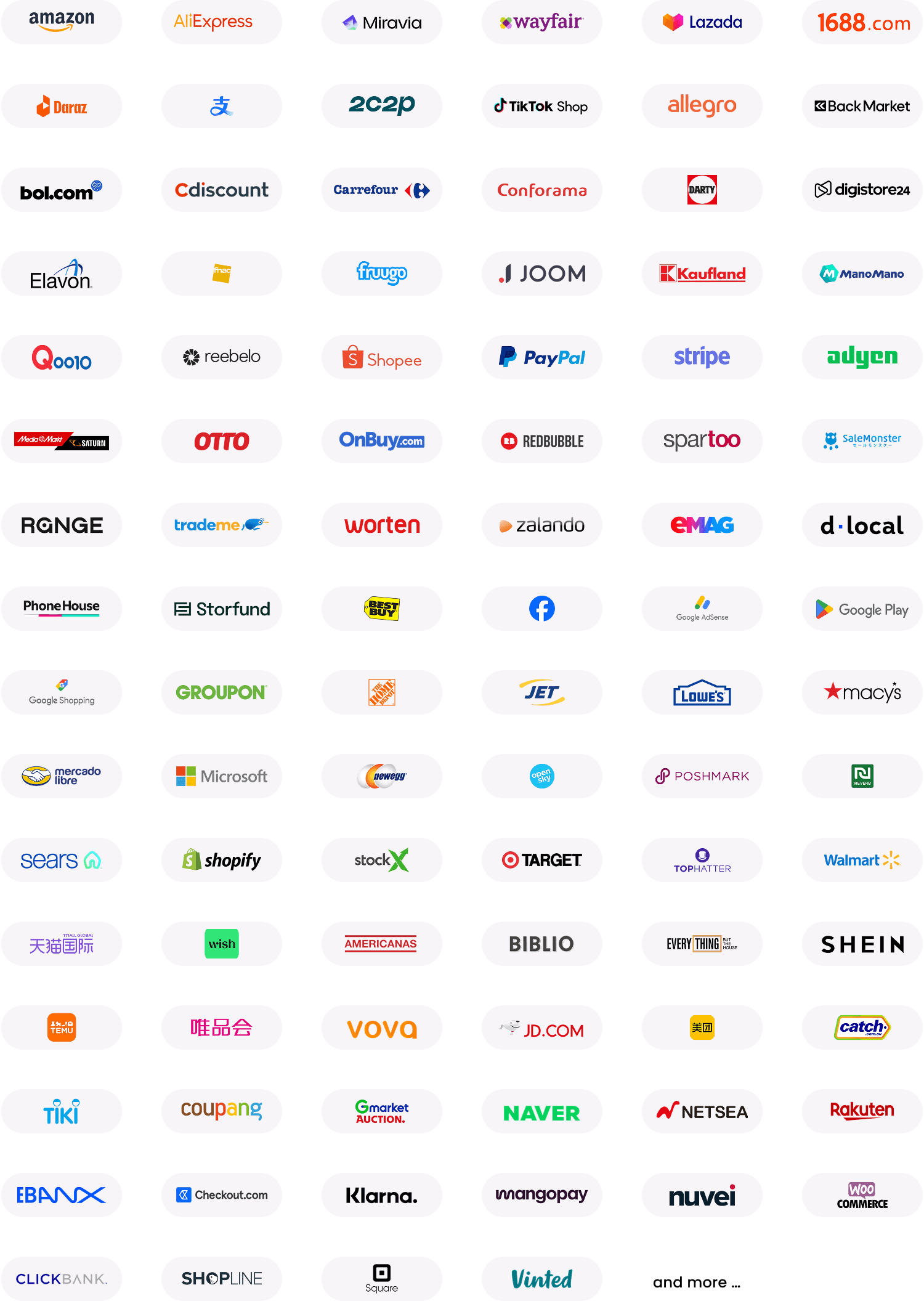Amazon sponsored advertising: how to optimise your way to a profitable Q4
The days of the “gut feel” are gone. In the 21st century, businesses that succeed do so by leveraging data.

The wisdom of being data-driven
A data-driven approach to business isn’t just a nice-to-have. It’s a means of recognising—and surmounting—our limitations as human beings, using to our advantage the universal truth that computers see things that we don’t.
In few domains are such data-driven insights more applicable than in Pay-per-Click advertising (PPC). Advertising algorithms have an often-uncanny ability to sniff out profitable keywords that the most gifted human intellect would never intuit.When it comes to PPC on Amazon, the same is true as is true of data science as a whole: if you’re not using it, you could be at a disadvantage.
And for Amazon sellers leveraging PPC, Q4 is crunch time.With the busiest time of the year looming large, how can sellers ensure they’re prepared for the chaos?
What to prepare for in Q4
Yuval Ben Nun, e-commerce consultant and former Chief Operating Officer of sponsored advertising agency PPCwinner, suggests to clients that one size does not fit all—and that a successful Q4 is made during Q3:
“Launching your PPC campaigns now will give Amazon’s algorithm plenty of time to index your ASINs (Amazon Standard Identification Numbers), giving them more exposure during Q4.
Veteran sellers with data from previous holidays should look to the past to prepare for the future. While each seller will have their own unique approach to PPC, the one goal everyone should have in common is to prepare, prepare, prepare.”
Ben Nun adds that preparation also means holding as much stock as possible andcautions sellers:
“If you’re about to run out of inventory, pause or slow your sales immediately. A stock-out will do far more damage to your business than the temporary hit to your sales volume.”
Q4 of 2021 is likely to exhibit other idiosyncrasies that set it apart from the pre-COVID-19 era, but with that said, sellers navigating the white-water rapids of Q4 for the first time can justify a bit of optimism.With many businesses sadly wiped off of the map altogether during lockdown, e-commerce has largely been a winning industry. More online orders have been placed, by more consumers, across more niches. This uptick is likely to endure as more people stick with the online shopping habits they formed during lockdown.
Q4-specific strategies
“How do I optimise my PPC for Q4?” is an impossible question to answer without answering the more generic question of “how do I optimise my PPC?”Sellers will have more success by following a two-pronged approach, recognising that there’s no sense in implementing Q4-specific techniques without building them on a solid foundation that will yield results year-round.
When and how to run your Q4 campaigns
Launch now!
Time is your friend when it comes to ranking for your main keywords. Amazon’s algorithm gives more love to long-running campaigns, and sellers constantly hopping from one campaign to another can expect to pay for their fickleness with higher CPC and reduced rankings.
With so many corporate juggernauts spending big bucks to cash in on the most lucrative quarter of the year, your rankings are likely to take a hit as 2023 draws to a close.
Q3 is the time to prepare for that hit.
Firstly, optimising your PPC campaigns now could yield well-established rankings more likely to withstand the competition.
Secondly, it ensures that you don’t pay over the odds for those rankings. In what can very rapidly become a David vs Goliath situation—with competition from big corporates driving CPC up to margin-squeezing levels—attempting to improve your rankings during the heat of Q4 can be an expensive business.
Depending on your budget and appetite for risk, spending money to secure your rankings now could save you money as Q4 unfolds.
Take advantage of CPC fluctuations
Do your own research to spot fluctuations in spending from your competitors.
Profitable keywords can turn unprofitable (and turn back again) in a dizzyingly short space of time. The same niche can be a gravy train and a graveyard in the same week, so make sure your margin spreadsheets are kept up-to-date. Researching once and then ticking it off your to-do list simply won’t cut it here.
Inventory management during Q4
Avoid stock-outs at all cost
Earlier, we touched on the first rule of inventory management: Don’t run out of stock!
Your metrics will take a serious hit if you find yourself unable to fulfil orders, and this can be an expensive problem to repair.
The spikes of Q4 make this a particularly important principle to bear in mind, since they often muddy the waters when it comes to forecasting sales accurately. Many an experienced seller has been caught off-guard by an unforeseen surge in order volume during the holiday season.
Can you increase inventory?
Inventory management can make or break your efforts as a seller. If you’ve evaluated your costs and determined that you can afford to allocate more capital to inventory, you could benefit from a busy Q4.
Though beyond the scope of this article and carrying a fairly stringent set of entry requirements, getting into Seller-Fulfilled Prime prior to Q4 may be beneficial to you if you’re eligible.
If you do think you’re at risk of running out of inventory, Ben Nun’s suggestion is to pause or slow your sales before it’s too late. Your first ports of call in this situation could be to:
- Stop or reduce your advertising. “Whether or not it makes sense to call a complete moratorium on your PPC will depend on your existing inventory levels. Do this as a matter of priority if you’re approaching a major holiday, leaving enough of a buffer to weather the storm should a flurry of unforeseen sales occur.”
- Raise your prices. “This could guardrail you against finding yourself short of stock (albeit less predictably than slowing your advertising), while making up for much of the sales shortfall with higher profit margins. Tread carefully here, making sure not to run afoul of Amazon’s stringent price-gouging regulations.”
Today’s preparation is tomorrow’s profit
Now more than ever, Q4’s success stories are decided in Q3. If financially viable, preparing your entire inventory for Q4 could stand you in good stead, saving you the anxieties of micromanaging your stock.
Maintain a particularly vigilant watch over your numbers as the holiday season proceeds and aim to beat your competitors tomorrow by out-preparing them today.
- Open 20+ local currency accounts and get paid like a local
- Pay suppliers, partners and staff worldwide in 100+ currencies
- Collect payments for free from 130+ marketplaces and payment gateways, including Amazon, Etsy, PayPal and Shopify
- Save with competitive exchange rates on currency conversions and transfers
- Lock in exchange rates for up to 24 months for cash flow certainty
A broader view: General PPC best practices
Much of what works in Q4 is every bit as applicable to the rest of the year. Following are some more general principles which should underpin your approach to PPC in its entirety, yielding greater profitability in Q4 and in the year as a whole.
When to drop a keyword
Hotly debated in PPC circles is the age-old question of when to drop a keyword. It’s a complex question, the answer to which far more resembles an art than a science.
If you’re dealing with a new ASIN, conversion is inevitably going to be lower. Give it time to mature. The true strength of a keyword takes time to reveal itself, and only does so in tandem with the maturation of other factors; among them, review count and the weight that Amazon’s algorithm itself gives to older listings.
This process might be likened to “waiting for the ripples on a lake to settle before being able to see the bottom clearly,” as there’s no getting around the fact that patience is a virtue here.
Once you understand this principle, it follows logically that when managing older listings, you should be less forgiving of poorly performing keywords. Such keywords are less likely to turn profitable once the underlying metrics have had time to solidify. Gold rushes rarely happen in old mines.
No-one can tell you where to set your budgets without an in-depth knowledge of your particular business, but as a rule of thumb, if the ASIN in question has been around for a while, you can more ruthlessly cull keywords which reach their budgets with few sales to show for it.
Finally, “if it ain’t broke, don’t fix it.” The stronger a keyword, the less sense it makes to tweak it. Approach profitable keywords with caution, applying only minor changes to the bids.
When it comes to the laggards, more drastic adjustments can be considered in attempts to make them profitable, while exact phrases should only be excluded when including them would be actively harmful (i.e. they’ve consistently spent money without generating sales).
How to lower your ACoS
It’s a question as old as advertising itself: how do you get more sales for less money?First and foremost, optimising your Advertising Cost of Sales (ACoS) starts with optimising your product detail pages.
One of the basic tenets of PPC is that there’s no sense in reaching a lot of shoppers with your ads if you’re just going to send them to a poorly optimised listing. “Filling a leaking bucket” is an apt analogy here.
Ben Nun provides some further guidance on how sellers can go about patching those leaks for good…
The dawn of video
“Video has become more ubiquitous on Amazon – it offers well-documented benefits for your on-page conversion rates, so be sure to take advantage of it if you have the option.”
Optimise your Amazon listings
Before looking at more advanced fixes, be sure that you’re making the most of the existing real estate on your product detail pages.
A surprising number of sellers fail to take full advantage of the number of characters allowed in descriptions and bullet points. Every word is an opportunity to improve your conversions—not to mention an opportunity to rank in Google and drive organic sales—so “max out” these basics as a starting point.
A+ Content is another boon to Brand Registered sellers. The feature expands your listings to include a richer set of images and copy, improving on-page conversion rate by up to 10% as per Amazon’s own estimation. Notably, A+ Content also gives mobile users a more immersive experience by appearing above the fold on product pages.
Tailor your listings to upcoming holidays
Another of the “low-hanging fruit” improvements to be had in preparing for Q4, adding holiday-specific keywords to your listings can give your ASINs some extra juice. You can reap SEO benefits by incorporating phrases geared towards key special occasions (e.g. Hallowe’en, Thanksgiving and Christmas) into your sales copy as the respective holidays approach.
Consider also giving your listings a Christmas makeover as the season approaches. You don’t need to go overboard here. A little tinsel goes a long way, and all that’s required to make your images stand out is a sprinkle of Christmas-themed artwork to complement your product images.
Ignore the last three days
Ben Nun offers another piece of advice when it comes to keeping an eye on your advertising metrics:
“Amazon’s PPC reports account for a campaign’s full performance stats three days in arrears, so don’t worry if something looks odd when analysing your metrics for the last couple of days. More importantly, don’t make any snap decisions based on what’s likely a simple reporting error.”
Remember the 80/20 rule
Don’t diversify yourself into oblivion.
Keep a close eye on which keywords are generating the bulk of your sales and nurture them.
The Pareto Distribution made famous by scientists and mathematicians (the dictum that 20% of the causes often generate 80% of the effects) rings true in the majority of PPC campaigns, with 20% of keywords often generating 80% of the sales, says Ben Nun.
The compulsion to “diversify” can drive overzealous sellers to sink an inordinate amount of budget into lacklustre keywords.
“Don’t put all your eggs in one basket,” while well-intentioned, is a maxim dangerously prone to being misapplied. To paraphrase legendary industrialist Andrew Carnegie: put all your eggs in a select few baskets and watch those baskets.
Never stop optimising
Long-term success in PPC is less about specific techniques than it is about assiduously making minor improvements and having the discipline to keep making them consistently.
Staple improvements include:
- Updating your bids continuously, depending on how they’ve been performing.
- Pruning keywords which are performing inadequately.
- Focusing the bulk of your ad spend on your most effective campaigns, and on your most profitable products.
- Using Amazon Coupons and Lightning Deals to spike sales
Above all, remember that optimising your campaigns, like gardening, is a job that’s never finished—only ever in progress. Data takes time to accumulate and attempting to rush the process is a false economy. Perseverance and discipline are more valuable assets here than technical brilliance.
Leverage your own data
While these guidelines are likely to benefit you regardless of the specifics of your niche, the fact remains that you’re the #1 expert on your own business.
Data is your friend. Try to analyse common themes from previous years, looking at your past successes and failures. If something’s worked particularly well for you in the past, it’s worth trying again.
Whatever your industry, your success as a business hinges on your ability to leverage data.
2020’s final quarter will bring with it challenges numerous and varied, but the businesses that come out ahead will do so, as they’ve always done, by cutting through those complexities to leverage their data more effectively.
As sellers navigate an e-commerce landscape that seems increasingly characterised by chaos, that enduring principle will continue to represent a beacon of stability—throughout Q4 and beyond.


Amazon seller payouts: Everything you need to know
If you’re selling on Amazon, your first questions will be, when will you get paid? In this guide, we share the details – and how WorldFirst helps.
Sep / 2025
The best e-commerce platforms in the UK
What are the best e-commerce platforms in the UK? Read about what to consider when selling on UK platforms and how to pick the right ones for you.
Jul / 2025
How to source products for e-commerce: A practical guide for scaling brands
E-commerce brands have many options when looking to source products. In this guide, we share the most strategic choices – and how WorldFirst helps.
Jul / 2025WorldFirst articles cover strategies to mitigate risk, the latest FX insights, steps towards global expansion and key industry trends. Choose a category, product or service below to find out more.
- Almost 1,000,000 businesses have sent USD$300B around the world with WorldFirst and its partner brands since 2004
- Your money is safeguarded with leading financial institutions



























































